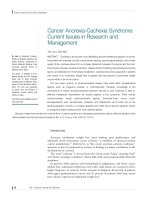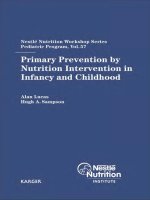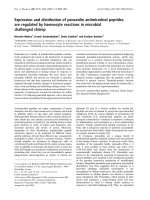Primary Prevention by Nutrition Intervention in Infancy and Childhood ppt
Bạn đang xem bản rút gọn của tài liệu. Xem và tải ngay bản đầy đủ của tài liệu tại đây (1.18 MB, 289 trang )
Primary Prevention by Nutrition Intervention in
Infancy and Childhood
Primary Prevention by
Nutrition Intervention in
Infancy and Childhood
Editors
Alan Lucas, London, UK
Hugh A. Sampson, New York, N.Y., USA
Nestlé Nutrition Workshop Series
Pediatric Program, Vol. 57
Nestec Ltd., 55 Avenue Nestlé, CH–1800 Vevey (Switzerland)
S. Karger AG, P.O. Box, CH–4009 Basel (Switzerland) www.karger.com
© 2006 Nestec Ltd., Vevey (Switzerland) and S. Karger AG, Basel (Switzerland). All rights reserved.
This book is protected by copyright. No part of it may be reproduced, stored in a retrieval system, or
transmitted, in any form or by any means, electronic, mechanical, photocopying, or recording, or
otherwise, without the written permission of the publisher.
Printed in Switzerland on acid-free paper by Reinhardt Druck, Basel
ISBN 3–8055–7978–0
ISSN 0742–2806
Library of Congress Cataloging-in-Publication Data
Nestlé Nutrition Workshop (57th : 2005 : Half Moon Bay, Calif.)
Primary prevention by nutrition intervention in infancy and childhood / volume editors, Alan
Lucas, Hugh A. Sampson.
p. ; cm. – (Nestlé Nutrition workshop series. Pediatric program ; v. 57)
“57th Nestlé Pediatric Nutrition Workshop, which took place in May 2005 at Half Moon Bay,
San Francisco”–Foreword.
Includes bibliographical references and index.
ISBN 3-8055-7978-0 (hard cover : alk. paper)
1. Diet therapy for children–Congresses. 2. Diet therapy for infants–Congresses. 3. Medi-
cine, Preventive–Congresses. I. Lucas, Alan, MD. II. Sampson, Hugh A. III. Title.
IV. Series: Nestlé Nutrition workshop series. Paediatric programme ; v. 57.
[DNLM: 1. Nutrition Therapy–methods–Child–Congresses. 2. Nutrition Therapy–methods
–Infant–Congresses. 3. Primary Prevention–methods–Child–Congresses. 4. Primary Preven-
tion–methods–Infant–Congresses. WS 130 N468p 2006]
RJ53.D53N47 2006
618.92Ј39–dc22
2005027723
The material contained in this volume was submitted as previously unpublished material, except in
the instances in which credit has been given to the source from which some of the illustrative material
was derived.
Great care has been taken to maintain the accuracy of the information contained in the volume.
However, neither Nestec Ltd. nor S. Karger AG can be held responsible for errors or for any
consequences arising from the use of the information contained herein.
Basel · Freiburg · Paris · London · New York ·
Bangalore · Bangkok · Singapore · Tokyo · Sydney
93 The Relationship of Breastfeeding to the Development of
Atopic Disorders
Zeiger, R.S.; Friedman, N.J. (San Diego, Calif.)
109 Prevention of Atopy and Allergic Disease: Type of Infant
Formula
Sampson, H.A. (New York, N.Y.)
125 Introduction of Solid Foods
von Berg, A. (Wesel)
Other Potentially Preventable Diseases
135 Osteoporosis: Is Primary Prevention Possible?
Fewtrell, M.S. (London)
153 Nutrition and Cancer Prevention: Targets, Strategies,
and the Importance of Early Life Interventions
Hursting, S.D.; Cantwell, M.M.; Sansbury, L.B.; Forman, M.R.
(Bethesda, Md.)
LC-PUFAs: Influence on Multiple Health Outcome
203 Long-Chain Polyunsaturated Fatty Acids in Early Life:
Effects on Multiple Health Outcomes
A Critical Review of Current Status, Gaps and Knowledge
Fewtrell, M.S. (London)
223 Perinatal PUFA Intake Affects Leptin and Oral Tolerance in
Neonatal Rats and Possibly Immunoreactivity in Intrauterine
Growth Retardation in Man
Hanson, L.Å.; Korotkova, M.; Hahn-Zoric, M. (Göteborg);
Zaman, S.; Malik, A.; Ashraf, R. (Lahore); Amu, S.; Padyukov, L.;
Telemo, E.; Strandvik, B. (Göteborg)
235 The Crucial Role of Dietary n-6 Polyunsaturated Fatty Acids
in Excessive Adipose Tissue Development: Relationship to
Childhood Obesity
Massiera, F. (Nice); Guesnet, P. (Jouy-en-Josas); Ailhaud, G. (Nice)
Contents
VI
Contents
VII
Impact of Nutrition on Health Mechanism Aspects
247 -Omics for Prevention: Gene, Protein and Metabolite Profiling
to Better Understand Individual Disposition to Disease
Affolter, M.; Bergonzelli, G.E. (Lausanne); Blaser, K. (Davos);
Blum-Sperisen, S.; Corthésy, B.; Fay, L.B.; Garcia-Rodenas, C.;
Lopes, L.V.; Marvin-Guy, L.; Mercenier, A.; Mutch, D.M.; Panchaud, A.;
Raymond, F. (Lausanne); Schmidt-Weber, C. (Davos); Schumann, A.;
Spertini, F.; Williamson, G.; Kussmann, M. ( Lausanne)
257 Concluding Remarks
267 Subject Index
IX
Foreword
For the 57th Nestlé Pediatric Nutrition Workshop, which took place in May
2005 at Half Moon Bay, San Francisco, the topic ‘Primary Prevention by
Nutrition Intervention in Infancy and Childhood’ was chosen. Early nutrition
seems to be involved in the mechanism of control, especially taking into
account the role of protein and long-chain polyunsaturated fatty acids (LC-
PUFAs). It seems that the new generation of infant formulas already takes
those findings into consideration.
We would like to thank the two chairmen, Prof. Hugh Sampson and Prof.
Alan Lucas who are recognized experts in this field, for putting the program
together and inviting the opinion leaders in the field of maternal and infant
nutrition as speakers.
Our first chairperson, Prof. Hugh Sampson, already chaired the 34th
Nestlé Nutrition Workshop entitled ‘Intestinal Immunology and Food Allergy’
in Versailles, France, in June 1993, a topic related to allergy and intestinal
immunity. Since then a lot of new data concerning this area have been
discovered and the results of the GINI study in Germany have confirmed the
hypothesis that mildly hydrolyzed whey-based formulas are effective in the
prevention of atopy. Having Professors von Berg, Björkstén, Zeiger and
Sampson around the table was a source of lively exchanges, discussions and
ideas resulting in strong and valuable conclusions.
Prof. Alan Lucas, our second chairperson, has substantially contributed
to our understanding of early nutrition and long-term outcome. With his co-
workers A. Singhal and M. Fewtrell, he is raising new hypotheses in the
development of obesity, diabetes, cardiovascular diseases later in life, the so-
called ‘syndrome X’.
We would also like to thank Mrs. Linda Hsieh and her team from Nestlé
USA, who provided all logistical support, enabling the participants to enjoy
the American hospitality.
Prof. Ferdinand Haschke, MD, PhD Dr. Philippe Steenhout, MD
Vice President and Chairman Medical Advisor
57th Nestlé Nutrition Workshop
Pediatric Program
Half Moon Bay, San Francisco, May 24–28, 2005
XI
Prof. Bengt Björkstén
National lnstitute of Environmental
Medicine
IMM Division of Physiology
Karolinska Institutet
SE–17177 Stockholm
Sweden
Tel. +46 8 52 48 69 56
Fax +46 8 30 06 19
E-Mail bengt.bjorksten@
admin.ki.se
Dr. Mary Fewtrell
MRC Childhood Nutrition Research
Centre
Institute of Child Health
30 Guilford Street
London WC1N 1EH
UK
Tel. +44 207 905 2389/2251
Fax +44 207 831 9903
E-Mail m.fewtrell@
ich.ucl.ac.uk
Prof. Lars Å. Hanson
Göteborg University
Department Clinical lmmunology
Guldhedsgatan 10
SE–413 46 Göteborg
Sweden
Tel. +46 31 342 4916/+46 31 342
4996
Fax +46 31 342 4621
Prof. Stephen D. Hursting
Division of Nutritional Sciences
University of Texas at Austin
1 University Station, A2700
Austin, TX 78712
USA
Tel. ϩ1 512 475 7931
Dr. Anja Kroke
Research lnstitute of Child Nutrition
Rheinische Friedrich-Wilhelms-
Universität Bonn
Heinstück 11
DE–44225 Dortmund
Germany
Tel. +49 231 79 22 10 17
Fax +49 231 71 15 81
Dr. Martin Kussmann
Nestec Ltd.
c/o Nestlé Research Center
PO Box 44
CH–1000 Lausanne 26
Switzerland
Tel. +41 21 785 9572
Fax +41 21 785 9486
E-Mail Martin.Kussmann@
rdls.nestle.com
Contributors
Chairpersons & Speakers
Contributors
XII
Prof. Zvi Laron
Endocrinology & Diabetes Research
Unit
Schneider Children’s Medical Center
of Israel
14 Kaplan Street
49202 Petach Tikva, Israel
Tel. +972 3 925 3610
Fax +972 3 535 1295
Prof. Alan Lucas
MRC Childhood Nutrition Research
Centre
lnstitute of Child Health
30 Guilford Street
London WCN 1EH, UK
Tel. +44 20 905 2389
Fax +44 20 404 7109
Dr. Claudio Maffeis
Department of Mother and Child
Biology – Genetics
Section of Pediatrics
University of Verona
Piazza L.A. Scuro, 10
IT–37134 Verona, Italy
Fax ϩ39 45 820 0993
Dr. Florence Massiera
Laboratoire ‘Développement du Tissu
Adipeux’
Centre de Biochimie –
CNRS UMR 6543
Parc Valrose – Faculté des Sciences
FR–06108 Nice Cedex 2, France
Tel. +33 4 92 07 64 39
Fax +33 4 92 07 64 04
Prof. Hugh A. Sampson
Department of Pediatrics
Jaffe Food Allergy Institute
Mount Sinai School of Medicine
Box 1198
New York, NY 10029-6574
USA
Tel. +1 212 241 5548
Fax: +1 212 426 1902
Dr. Atul Singhal
MRC Childhood Nutrition Research
Centre
Institute of Child Health
30, Guilford Street
London WC1N 1EH
UK
Tel +44 20 7905 2389
Fax +44 20 7831 9903
Dr. Andrea von Berg
Forschungsinstitut an der
Klinik für Kinder- und
Jugendmedizin
des Marien-Hospital Wesel
Pastor-Janssen-Strasse 8–38
DE–46483 Wesel
Germany
Tel. +49 281 104 1179
Fax +49 281 319 1659
E-Mail vonberg@
marien-hospital-wesel.de
Dr. Robert S. Zeiger
Kaiser Permanente Medical Center
Department of Allergy-lmmunology
7060 Clairemont Mesa Boulevard
San Diego, CA 92111
USA
Tel. +1 858 573 5408
Fax +1 858 573 5251
Prof. Dennis M. Bier
USDA/ARS Children’s Nutrition
Center
1100 Bates Street
Houston, TX 77030
USA
Tel. +1 713 798 7022
Fax +1 713 798 7022
Contributors
XIII
Moderators
Prof. Steven Abrams
USDA/ARS Children’s
Nutrition Research Center
1100 Bates Street
Houston, TX 77030, USA
Tel. +1 713 798 7124
Fax +1 713 798 7119
Prof. Craig Jensen
Baylor College of Medicine
Texas Children’s Hospital MC1010.00
6621 Fannin Street
Houston, TX 77030, USA
Tel. +1 832 822 3611
Fax +1 835 825 3633
E-Mail cljensen@
texaschildrenshospital.org
Prof. William Klish
Baylor College of Medicine
Texas Children’s Hospital MC1010.00
6621 Fannin Street
Houston, TX 77030, USA
Tel. +1 832 822 3616
Fax +1 835 825 3633
Prof. Alan Lake
10807 Falls Rd
Lutherville, Maryland 21093
USA
Tel. +1 410 321 9393
Fax +1 410 825 4945
Prof. José Saavedra
Nestlé USA, Nutrition Division
800 N. Brand Blvd.
Glendale, CA 91203
USA
Tel. +1 818 549 6774
Fax +1 818 549 5704
E-Mail jose.saavedra@
us.nestle.com
Invited attendees
Prof. Elza Daniel de Mello/Brazil
Prof. Angela Mattos/Brazil
Dr. Thomas J. Bowen/Canada
Prof. Zave Chad/Canada
Prof. Ernest Seidman/Canada
Dr. Eduardo Atalah/Chile
Dr. Xiaochuan Wang/China
Dr. Dorian Tjesic-Drinkovic/Croatia
Dr. Duska Tjesic-Drinkovic/Croatia
Dr. Jose Luis Abreu/Dominican
Republic
Prof. Manuel Garcia Sugranes/
Dominican Republic
Dr. Rafael Aulestia/Ecuador
Prof. Enrique Bolona/Ecuador
Mrs. Aila Paganus/Finland
Prof. Otto Schofer/Germany
Dr. Alexander Andreou/Greece
Prof. Eleftheria Roma/Greece
Dr. Emmanouil Manousakis/Greece
Dr. Eva Micskey/Hungary
Badriul Hegar Syarief/Indonesia
Arinda Yunanto/Indonesia
Prof. Adib Moukarzel/Lebanon
Dr. Olga Zimanaite/Lithuania
Dr. Angel Carlos/Mexico
Dr. Eustorgio Garcia/Mexico
Dr. Raul Garza/Mexico
Dr. Sofia Leyva/Mexico
Dr. Ricardo Reyes Retana/Mexico
Dr. Enrique Rodriguez/Mexico
Prof. Per Finne/Norway
Dr. Alfredo Mora/Panama
Gerado Rivera/Panama
Dr. Rommel Bernardo/Philippines
Dr. Augustus Manalo/Philippines
Prof. Virginia Tanueco/Philippines
Dr. Luis Pereira-da-Silva/Portugal
V
Contents
IX Foreword
XI Contributors
Introduction
1 Infant Nutrition and Primary Prevention: Current and Future
Perspectives
Lucas, A. (London); Sampson, H.A. (New York)
Reduction in Risk of Cardiovascular Diseases
15 Nutritional Interventions in Infancy and Childhood for
Prevention of Atherosclerosis and the Metabolic Syndrome
Singhal, A. (London)
31 Childhood Obesity: Potential Mechanisms for the
Development of an Epidemic
Maffeis, C. (Verona)
51 Prenatal and Postnatal Development of Obesity:
Primary Prevention Trials and Observational Studies
Kroke, A. (Dortmund)
67 Childhood Diabetes Mellitus with Emphasis on Perinatal
Factors
Laron, Z. (Tel Aviv)
Prevention of Atopy, Allergy and Infectious Diseases
81 The Gut Microbiota and Potential Health Effects of
Intervention
Björkstén, B. (Stockholm)
Dr. Saleh Al-Alaiyan/Saudia Arabia
Dr. Michael Greeff/South Africa
Dr. Manuel Martin Esteban/Spain
Dr. Ine Martinah Mingoen/Suriname
Prof. Mehari Gebre-Medhin/Sweden
Prof. Christian Braegger/Switzerland
Dr. Somporn Chotinaruemol/Thailand
Prof. Zulaika Ali/Trinidad & Tobago
Prof. David Picou/Trinidad & Tobago
Dr. Rajindra Parag/Trinidad & Tobago
Dr. Lynette Welch/Trinidad & Tobago
Dr. Assia Turki-Hammami/Tunisie
Prof. Aziz Sheikh/UK
Dr. Lillian Beard/USA
Dr. Stuart Cohen/USA
Mrs. JoAnn Hattner/USA
Dr. Robert N. Hamburger/USA
Dr. John Kerner/USA
Dr. Ricardo Sorensen/USA
Dr. Ekhard Ziegler/USA
Dr. Bich Chi Pham/Vietnam
Nestlé participants
Prof. Carlos Nogueira de Almeida/
Brazil
Mrs. Shaunda Durance-Tod/Canada
Andrea Papamandjaris/Canada
Mrs. Lis Vinther/Denmark
Mr. Elias Papadopoulos/Greece
Veronidia Ventura/Philippines
Prof. Antonio Guerra/Portugal
Mrs. Mabel Labuschagne/South Africa
Dr. Anette Jarvi/Sweden
Dr. Irene Corthesy/Switzerland
Dr. Bianca-Maria Exl-Preysch/
Switzerland
Dr. Marie-Claire Fichot/Switzerland
Prof. Ferdinand Haschke/Switzerland
Mr. Charly Huber-Haag/Switzerland
Dr. Martin Kussman/Switzerland
Mr. Philippe Steenhout/Switzerland
Prof. Marco Turini/Switzerland
Dr. Peter Van Dael/Switzerland
Mrs. Nicola Bradley/UK
Ms. Cynthia Brown/USA
Ms. Cynthia Busby/USA
Ms. Nina Carroll/USA
Ms. Julie Dunmire/USA
Ms. Kelly Green/USA
Ms. Linda Hsieh/USA
Ms. Kathleen Novak/USA
Ms. Lisa Reavlin/USA
Mr. Ernie Strapazon/USA
Contributors
XIV
Infant Nutrition and Primary Prevention:
Current and Future Perspectives
A. Lucas
a
, Hugh A. Sampson
b
a
MRC Childhood Nutrition Research Centre, lnstitute of Child Health, London, UK; and
b
Jaffe Food Allergy Institute, Mount Sinai School of Medicine, New York, USA
In the past two decades there has been a major change in focus in the field
of nutrition. Previously, the main interest was meeting nutritional needs; now
the major emphasis is the impact on health. Indeed, our new understanding of
the biological effects of nutrition that influence health has revealed the
immense potential for nutrition in primary prevention.
The Concept of Primary Prevention
Primary prevention is generally considered as the prevention of a disease
before it occurs, or reduction of its incidence. However, this concept needs to
be expanded here since early nutritional interventions are often targeted
towards optimizing neurodevelopmental potential. Therefore, the suggested
definition of primary prevention for this Workshop is as follows:
To prevent or reduce the risk of disease and prevent impairment of
cognitive potential
The means of achieving primary prevention by nutrition is through
education, clinical or public health practice or intervention, and through
policy, legislation and regulation. However, these strategies are all dependent
on the establishment of a solid research base – the focus of this Workshop.
Research in primary prevention may and should have a fundamental basis, as
considered in several chapters, but ultimately effective prevention strategies
depend on formal evidence-based research that establishes the impact of
nutrition on health and developmental outcomes.
Impact of Nutrition on Health
Nutrition has the potential to influence health in a broad variety of ways,
which may be usefully categorized as in table 1.
Lucas A, Sampson HA (eds): Primary Prevention by Nutrition Intervention in Infancy and Childhood.
Nestlé Nutr Workshop Ser Pediatr Program, vol 57, pp 1–13,
Nestec Ltd., Vevey/S. Karger AG, Basel, © 2006.
1
Introduction
In the following sections I shall give illustrations in each of these categories,
taking for convenience data from my own center’s work, simply to illustrate
some concepts that underlie the large array of examples that will emerge at
this Workshop.
Short-Term or Immediate Effects of Nutrition
Primary prevention may occur during a short-term intervention. An
important example is the effect of human milk in neonatal intensive care in
preventing life-threatening necrotizing enterocolitis (NEC) or neonatal
sepsis. For instance, our own study on 926 preterm infants under 1,850 g
birth weight [1] showed that in exclusively formula-fed infants confirmed
NEC occurred in 7.2%; whereas in those partially or totally human milk-fed
NEC occurred in only 2.5 and 1.2%, respectively. Above 30 weeks gestation,
when other risk factors for NEC are less common, diet emerged as
particularly influential, with 1/20 of the rate of NEC in those fed human
milk versus formula. Indeed in a national survey of NEC (unpublished) those
above 30 weeks fed predominantly human milk who developed NEC had a
mortality of 5%, compared to 26% in those predominantly formula-fed.
Further work from a randomized trial [2] and observational data also show a
major reduction in neonatal sepsis in those fed human milk.
In general, when appraising the ‘prevention potential’ for a nutritional
intervention, there are three key factors to consider: (a) the quality of
evidence available; (b) the size of the effect demonstrated, and (c) the
feasibility of the intervention.
In the above example, the evidence that breast milk reduces the risk of
NEC or sepsis is based on numerous observational studies, some randomized
trial data and biological plausibility; the effect size is large, and in terms of
feasibility, counseling of mothers of preterm infants to provide at least some
expressed breast milk has been effective. Thus, use of breast milk in neonatal
care for primary prevention is widely employed.
Lucas/Sampson
2
Table 1. Impact of nutrition on health
1 Short-term or immediate effects
2 Long-term effects
‘Programming’ during critical periods
Impact of nutrition throughout childhood
3 Diet as a ‘vehicle’ for factors that impact on health
Long-Term Impact of Nutrition
Nutrition as a ‘lifestyle’ factor throughout childhood has raised consi-
derable interest in relation to a number of disease processes, particularly
obesity and associated non-insulin-dependent diabetes in view of the current
epidemic – a major focus of this Workshop. Here, however, I shall consider
perhaps the fastest growing area of current nutritional research: ‘programming’,
and its relationship to prevention.
Programming was defined by Lucas [3] as the concept that a stimulus
or insult, when applied to a critical or sensitive period in development may
have a long-term or life-time effect on the structure or function of the
organism.
Background
The concept of ‘critical periods’ dates back to Spalding’s formal descrip-
tion in the 19th century of ‘imprinting’ in chicks. The first evidence for
nutritional programming came from the work of McCance [4] in animals in
the early 1960s demonstrating in rats the long-term impact of neonatal
nutrition on adult size. Since then numerous animal studies including those in
primates have shown that in adulthood nutrition may program such outcomes
as blood pressure, lipid metabolism, insulin resistance, atherosclerosis, bone
health, learning, behavior and even lifespan [3–9].
Given the immense potential for disease prevention raised by this work,
corresponding studies in humans have been imperative. In 1982 we initiated
the first formal intervention trials, based on the pharmaceutical trial model,
to test the programming concept in humans [10], first in preterms then full-
term infants. From the later 1980–1990s there was also an explosion of
retrospective observational studies relating size in early life (as a putative
marker of nutrition) to later disease [11].
Programming Effects on Cardiovascular Disease
Breastfeeding is now emerging as important in the primary prevention of
cardiovascular disease risk [12]. Numerous observational studies in healthy
full-term infants have shown that breastfeeding is associated with a later
reduction in insulin resistance, blood pressure, LDL cholesterol and obesity –
the latter three, the subject of formal meta-analyses. However to confirm
causation, studies on preterm infants have been important since it is possible,
in those whose mothers elect not to provide breast milk, to conduct formal
randomized outcome trials comparing donated banked breast milk with
formula. Moreover, because breast milk intake in preterms can be recorded
accurately (since it is fed by nasogastric tube), a ‘dose-response relationship’
between intake and later outcome can be explored – important, if found, in
supporting causation.
Infant Nutrition and Primary Prevention
3
Our own such trials on preterm infants provide experimental evidence that
human milk feeding in the neonatal period reduces, later in adolescence,
blood pressure, LDL cholesterol, insulin resistance and leptin resistance
(metabolic tendency to obesity), and the greater the human milk intake the
greater the benefit [13–16]. Thus, extensive evidence in term and preterm
infants, now including experimental evidence from formal outcome trials,
shows that human milk reduces the key features of the metabolic syndrome –
the major risk complex for cardiovascular disease.
In a recent review Singhal and Lucas [12] linked these findings into a
broader concept – the postnatal growth acceleration hypothesis. This
hypothesis is based on extensive evidence from studies in diverse animal
species [17] (from butterflies to primates), human observations [18, 19] and
now our own experimental interventions on preterm and full-term infants,
that rapid growth acceleration (upward centile crossing) in the early
postnatal period increases later cardiovascular disease risk. Thus the
advantage for breast milk-fed infants could be related to their slower early
growth rate [12].
The potential long-term impact of breast milk feeding or other strategies to
prevent early growth acceleration is large. In our trials the impact on later
blood pressure of either breast milk in preterm infants or using a standard
versus nutrient-enriched formula in small-for-gestational age full-term infants
[12] was over 3 mm Hg. Yet, the Framingham study noted that just a 2-mm
reduction in population diastolic blood pressure would result in around
100,000 less strokes and coronaries in the US each year. The impact of breast
milk on later cholesterol – around a 10% reduction – would, in adults, reduce
cardiovascular risk by 25% and mortality 13–14% [12].
Programming and the Brain
The programming effect of early nutrition of the brain is equally important
in terms of primary prevention. In a randomized trial in preterm infants, use of
a standard versus enriched preterm formula (in the early 1980s, when
standard formulas were often used) resulted in a major deficit in later IQ,
reaching 13 verbal IQ points in males [20]. Those (males and females) fed the
standard formula had, at 7–8 years, a 38% incidence of some degree of mental
or motor impairment compared to only 15% in the group fed the enriched
formula. Our (unpublished) evidence shows that the cognitive effects persist
into early adulthood when we have also found differences between rando-
mized groups in the structure of the brain (using MRI scanning with statistical
parametric mapping). In term infants, previous studies on the impact of
undernutrition on neurodevelopment were observational and confounded by
poverty and poor social circumstances. However, the first randomized trials of
early nutritional supplementation in developing countries are beginning to
demonstrate the long-term cognitive effects of early nutrition [21]. Never-
theless, the effect-size appears greater in those born preterm.
Lucas/Sampson
4
The impact of specific nutrients (e.g. iron, zinc, taurine, long-chain
polyunsaturated fatty acids) and of breastfeeding are also receiving much
study, and have considerable potential for the prevention of reduced
cognitive performance [21].
Balance of Risks
It is of interest, however, that whilst a high plane of early nutrition is
important for brain development, a lower plane of nutrition and growth
appears to favor cardiovascular health, as discussed above. This apparent
conflict requires risk-benefit analysis. In preterm infants, the brain is
particularly sensitive to the impact of nutrition. For this reason, a high plane
of nutrition and growth takes precedence – hence the rationale for breast
milk fortifiers and multi-nutrient-enriched preterm formulas in neonatal care.
However, in full-term infants, whilst early nutrition appears to have a major
impact on later cardiovascular risk, the impact on the brain appears less than
in preterms. Whilst further research is needed, these findings in healthy
infants suggest slower early growth, as seen with breastfeeding, would be
more optimal.
Diet as a Vehicle for Factors That Impact on Health
The human diet is a complex medium that may act as a vehicle for
numerous factors that can influence short and long-term health. These
include pathogenic organisms (e.g. HIV in breast milk and Enterobacter
sakazakii in infant formulas), environmental contaminants (e.g. dioxins,
phytoestrogens) and a variety of potentially toxic factors. It is one of the
latter, aluminum, I shall cite as an illustrative example here.
Parenteral aluminum has long been known to be neurotoxic. Before its
removal from renal dialysis solutions, patients became frankly demented.
However, intravenous feeding solutions used in the pediatric population may
be significantly contaminated with aluminum, for instance, in calcium
gluconate [22]. We tested the hypothesis that in preterm infants, frequently
fed intravenously and born at a sensitive stage of brain development and
with limited excretory capacity, parenteral aluminum might be especially
neurotoxic. A large randomized trial was conducted comparing those fed on
regular total parental nutrition (TPN) versus a specially sourced low
aluminum TPN including calcium chloride rather than gluconate [22]. At the
18-month follow-up those receiving more than the median number of days of
TPN for the cohort (9 days) had a 10-point deficit in the mental development
index (MDI) if fed on the standard versus low aluminum solution in the
newborn period. Taking the whole cohort, each day of standard TPN solution,
as fed in many Western units, was associated with loss of 1 MDI point [22].
This illustrates the importance of achieving high standards of quality control
Infant Nutrition and Primary Prevention
5
of feeds for infants in relation to primary prevention. Such control is often
best achieved at a legislative or regulatory level.
Research Issues in Primary Prevention
Whilst the potential for primary prevention via nutrition is high, research
in this area is complex. I shall consider here an illustrative selection of key
research issues listed in table 2.
Critical Interactions
Nutrition may interact with genes, subject characteristics, and environ-
mental factors.
Genetic Factors
Interaction between early diet and family history for later risk of atopy
provides an instructive model. Whilst all observational studies comparing
breast and formula feeding are confounded by demographic factors, preterm
infants provide an opportunity for randomly comparing human milk (from a
milk bank) with formula (see above). In the only such randomized outcome
trial for atopy [23], those with a family history of atopy who were randomly
assigned to formula versus human milk in the neonatal period had over twice
the incidence of eczema, nearly three times the incidence of food and drug
reactions and a strong trend of more wheezing at 18 months follow-up.
Conversely, in those with a negative family history, there was trend in the
opposite direction [23]. Indeed, in a further trial of preterm versus term
formula where the former group had higher cow’s milk protein intake, in
those with a negative family history of atopy, infants receiving the greatest
cow’s milk protein intake had the lowest incidence of atopy 18 months later
[23]. Thus, whether later tolerance or sensitization occurred appeared to be
genetically determined.
Lucas/Sampson
6
Table 2. Research issues in primary prevention by
nutrition in infancy and childhood
Critical interactions
Timing of the window
Emergence of the effect
Quality of evidence required
Risk-benefit analyses
Mechanism
More work is needed to identify specific genes that interact with the diet.
In young adults we found that early evidence of the atherosclerotic process
(reduced flow-mediated endothelial-dependent arterial dilatation) was dose-
related to the plasma n-3 fatty acid level (principally related to fish intake).
However, this beneficial effect of fish intake on later vascular health was
only seen in glu298asp heterozygotes (30% of the population) of the eNOS
gene (influential for vascular health); the glu298glu homozygotes were
unaffected [24].
These data illustrate that genetic characterization of family history may be
needed in some primary prevention studies to identify the optimal target
group for intervention.
Subject Characteristics
Not all subgroups within a population are equally affected by diet. In most
studies, including our own, on nutrition and later neurodevelopment, males
show the major response [20]. This is also seen in the extensive
corresponding animal literature [8]. Furthermore, in an unpublished 15- to
18-year follow-up we found that higher verbal IQ after using a nutrient
enriched diet (see above) was only seen in appropriate- and not small-for-
gestational-age infants.
Thus, again, target subgroups within a population that respond most
favorably to the nutritional intervention require identification.
Environmental Interactions
One of the most concerning interactions in the programming area is that
between infant diet and our subsequent Western environment – probably our
Western diet.
In the 1980s Lewis et al. [7] assigned baboons to breast versus formula
feeding during infancy and then placed both groups on a ‘Western-style’ diet,
rich in saturated fats, to test whether early nutrition in a Western context
could influence later cardiovascular health. In adulthood, the previously
breastfed group appeared the disadvantaged one in terms of higher LDL
cholesterol, lower HDL, higher cholesterol absorption from the gut and
reduced cholesterol excretion. Thus, the previously breastfed baboons
appeared to be programmed to ‘conserve’ cholesterol – perhaps an advantage
in the ‘wild’ on a natural diet. But on a Western diet, this became disad-
vantageous, emphasized by the postmortem evidence that throughout the
arterial tree, the previously breastfed group had around twice the area of
early atherosclerosis compared to the previously formula-fed group [7].
Later, Barker [11] noted that whilst breastfeeding was associated with
lower rates of ischemic heart disease overall, if prolonged beyond a year in
more vulnerable males, it was associated with increased ischemic heart
disease. More recently we showed in 400 20- to 30-year-olds that, beyond 3–4
months of breastfeeding (not exclusive), increasing duration was associated
Infant Nutrition and Primary Prevention
7
with progressive worsening of vascular distensibility 20–30 years later [25].
This is now supported by a further Scandinavian study also showing that
vascular health in 10-year-old children was worse in those who were
breastfed longer.
These studies [7, 11, 25] collectively raise the hypothesis that breast-
feeding, if sufficiently prolonged, is an adverse risk factor for cardiovascular
disease when followed by a Western diet. Thus, breastfeeding overall is
beneficial for vascular health – but the optimal duration in the West is
unknown. Of course, the data impugn our Western diet rather than breast-
feeding and prolonged breastfeeding is not in any way challenged in
developing countries. There are also other outcome benefits for breastfeeding.
Nevertheless, in a Western context, research in this area is now critical.
Taking these interactions collectively, the research implication is that:
The impact on health of a nutrition intervention may be highly
influenced by genes, subject characteristics and by current and future
environment.
Timing of the Window
Defining the optimal window for nutrition intervention is a key research
issue. For cardiovascular programming the period beyond birth (whether
term or preterm) appears to be a particularly sensitive one [12]. Conversely,
for the brain, gestation appears important so that term infants may be less
sensitive (not insensitive) than those born preterm.
With regard to cardiovascular disease, a key research question has been
whether prevention is best achieved by prenatal or postnatal intervention.
Whilst there is extensive evidence that fetal environment may influence
outcome, when birth weight is taken as a measure of fetal growth, its
relationship with later cardiovascular risk factors (blood pressure, insulin
resistance and LDL cholesterol) is small; whereas the impact of postnatal
nutrition based on both experimental and observational studies, is large [12].
Fetal growth manipulation is also difficult to achieve whereas postnatal
nutrition can be modified practically. More work is needed, but the postnatal
period is emerging as an important one in terms of prevention potential for
cardiovascular disease. Thus:
The efficacy of a prevention strategy may be highly influenced by its
timing.
Emergence of the Effect
Lewis et al. [9] showed in baboons that overfeeding in infancy resulted only
in a temporary increase in body weight which then remained normal throughout
Lucas/Sampson
8
‘childhood’. However, those overfed in infancy became progressively obese in
adulthood; an excellent example of programming, in which a ‘memory’ had
been retained of the early intervention, yet outcome effects were not
expressed until adulthood.
Examples of late-emerging effects are found in humans. In our own trial
(cited above) preterm infants randomly assigned to human milk or formula in
the neonatal period, showed no difference in blood pressure at 7–8 years, but
a major reduction in blood pressure was seen in those fed human milk by
13–16 years [14]. A more disturbing example was found in our randomized
trial of a formula with and without long-chain polyunsaturated fatty acids
(LCPUFA). In all, 460 full-term subjects were studied including a reference
group. Follow-up at 18 months showed no differences in developmental scores
between groups [26]; but at 4–6 years, the group given LCPUFA had a
significant 6-point reduction in IQ (unpublished). Our other LCPUFA trials
show that outcome is dependent on source (see Chapter X), and other sources
of LCPUFA have not had this adverse effect. Nevertheless taking these late-
emerging programmed effects collectively a clear research message emerges:
Long-term follow-up is essential in intervention trials of early
nutrition to ensure detection of late emerging effects, which may have
implications for safety as well as efficacy.
Quality of Evidence Required in Studies on Prevention
Many health practices in nutrition are defended only by observational data,
which are often confounded (for instance differences in breast- and formula-
fed infants). It is difficult therefore to use such data to prove causation and
hence underpin health practices.
An example of the difficulty in establishing causation from observational
data comes from the observed relationship between birth weight and later
insulin resistance, interpreted as fetal programming [15]. However, in our
own randomized trial demonstrating experimentally the influence of
postnatal diet on later insulin resistance in adolescence, we were able to do
an instructive secondary analysis. Birth weight, postnatal growth and, of
course, postnatal nutrition were each found to be significantly related to later
insulin resistance. However, when all three were placed as independent
variables in the same regression model, only postnatal growth remained
significantly related to insulin resistance [15]. This suggested that postnatal
growth explained the effect of postnatal nutrition, but also the birth weight
effect. If so, birth weight may be more a proxy for future growth (postnatal
catch-up, which occurs more at lower birth weight), rather than fetal growth,
as previously assumed.
As a reflection of the potential dangers of formulating practice recom-
mendations on the basis of observational data, retrospective studies had
Infant Nutrition and Primary Prevention
9
suggested promotion of postnatal growth would be advantageous for later
cardiovascular disease risk [27]; yet experimental studies in both animals and
humans have now shown the opposite, as discussed above. In conclusion:
Wherever possible, experimental studies form a more secure basis for
proof of causation and for underpinning practice than observational
ones.
Risk-Benefit Analyses
The evidence that more rapid growth favors the brain yet slower growth
favors later cardiovascular health indicates the need for risk-benefit analyses
in the formulation of health practices, as discussed above. A more general
message emerges from this, namely that:
It may not be safe to devise nutrition policies solely on the basis of the
outcome of interest to the investigator. A broader range of outcomes may
be needed to define an optimal intervention strategy.
Research into Mechanism
Whilst not the focus of this introductory paper, I shall consider here a few
illustrative aspects of mechanistic research. An understanding of mechanism
is not a prerequisite for developing effective prevention practices though
clearly should be a goal for future development of the field. Such research
needs to be a number of levels, as listed in table 3.
Substantial research at a basic biological level is now directed at the
descriptive biology and fundamental mechanisms involved in programming
and the health impact of early nutrition.
Within the genetic sphere, one area of focus has been the genetic
propensity to respond to the nutritional stimulus – that is, nutrient–gene
interactions (as discussed above). However, of greater fundamental interest
is the converse phenomenon – the impact of nutrition on genetic expression.
Lucas [10] proposed that the ‘memory’ of the original nutritional programming
Lucas/Sampson
10
Table 3. Levels of mechanistic research on prevention
Genomics, omics and cell biology
Physiology
Structure
Behavior
Anthropology
Evolution









